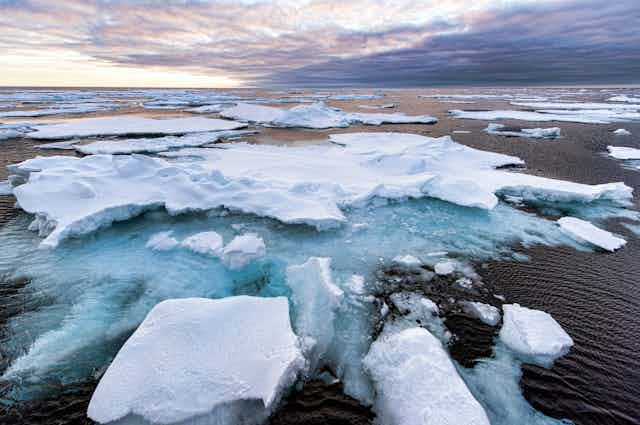Norway has a reputation for environmental leadership, from championing international biodiversity policies to its wilderness protection and ambitious biodiversity regulations.
Now it is leading into another area, leveraging its long legacy of offshore oil and gas production into developing deep-sea mining.
In January Norway became the first nation to open its continental shelf to commercial deep-sea mineral exploration. The approved proposal opens the door for “sustainable and responsible” exploration within an area of 281,000 square kilometres, roughly the size of Italy.
Read more: Deep-sea mining may wipe out species we have only just discovered
But determining what constitutes sustainable and responsible deep-sea mining could put Norway in murky legal waters by pushing the boundaries of several international agreements to which it is a signatory. Beyond legal action, Norwegian society, businesses and global politics will play a part in deciding how this controversial industry develops. Other countries, such as Canada, should take note.
While the current government of Canada opposes deep-sea mining and has issued a domestic moratorium, there are Canadian companies lobbying for this industry to open in international waters. But there are more than a few hurdles in the way of a booming deep-sea mining industry — and for good reason.
Mining in the deep
The proposal to authorize deep-sea mining was initiated by the ministry that has overseen Norway’s huge offshore oil industry for decades. It was asked to map “commercially interesting mineral deposits on the Norwegian continental shelf” and found sulphides and manganese crusts with high concentrations of copper, zinc and cobalt, as well as rare earth elements.

The technologies needed to mine manganese crusts differ than those needed to mine sulphides. Manganese crusts are mined by scraping thin layers of minerals off of the edges of the deep-sea rocks, said Walter Sognnes, CEO of deep-sea mining company Loke Marine Minerals based in Norway, whom I interviewed for this story. Whereas, sulphides are mined by drilling into the seabed using technology from the oil and gas industry.
Norway’s Ministry of Energy believes that the minerals from deep-sea mining could both meet the demand required of the green energy transition and secure the supply. But opposing scientists and organizations argue that this logic is flawed.
Opponents of deep-sea mining say that it will irreversibly damage biodiversity and ecosystems, and warn that it will impact fisheries, cause sediment plumes, damage the seabed, increase pollution and contribute to several other spillover effects.
If the Norwegian government advances deep-sea mining beyond the exploration phase, Sognnes expects that full-scale mining operations could be underway in Norway by the early 2030s.
Norway’s continental shelf
Under United Nations law, coastal countries have a 200 nautical mile Exclusive Economic Zone extending out from their coastlines within which they have the right to explore and use the resources on the seabed and water column.
This is true for Norway, however, in 2009 Norway’s request to extend its continental shelf was approved by a governing body at the UN. This decision further added 235,000 square kilometres of seabed to Norway’s territory — though the water above the seabed is, crucially, not included as Norwegian territory.
That means that Norway’s proposed deep-sea mining activities will take place on the seabed, under Norway’s jurisdiction. However, as professor of maritime law at the University of Oslo Alla Pozdnakova described to me, any mining activities on Norway’s patch of sea-bed will “inevitably affect the water column where the (High Seas) Treaty will eventually apply” — with potentially significant legal repercussions.
The High Seas — or not?
In 2023, the UN’s High Seas Treaty was adopted by more than 80 nations — including Norway — and is meant to manage the two-thirds of the oceans outside any one country’s responsibility.
Mining brings many complicated legal issues that could involve the High Seas Treaty, said Pozdnakova.
For example, any of the 80 countries that signed the High Seas Treaty could propose a marine protected area anywhere in the high seas. In theory, this could be an area that Norway plans to deep-sea mine.
It’s also important to note that while the High Seas Treaty has been signed by Norway, it has not yet come into effect. But the timing of the treaty being ratified by Norway could align with deep-sea mining operations entering an exploitation phase, said Pozdnakova, which could further complicate the legal and political landscape for Norway.
There are also regional agreements that could raise concerns.
The Svalbard Treaty, for example, is an agreement signed by Canada and 45 other countries. The treaty gives Norway sovereign rights over the archipelago. And it calls for equality between the signatories when it comes to maritime, industrial, mining and commercial activities.
Pozdnakova notes that there is some debate about the geographic extent of the treaty, which was signed in 1920. But depending on the treaty’s extent, some of the proposed area could overlap.
“Once some companies get a license…then immediately you have this issue going on about whether the Svalbard Treaty applies to this particular area and what it means,” said Pozdnakova.
The convention that protects the marine environment of the North-East Atlantic Ocean, known as the OSPAR Convention, could also raise concerns about deep-sea mining’s impact in the region from sediment plumes to impacts on fisheries and others. However, the convention does not prohibit Norway’s activities on its continental shelf, said Pozdnakova.

Beyond the laws
Several countries, including Canada, France and others, have called for a moratorium or precautionary pause on deep-sea mining in “areas beyond national jurisdiction.”
Norway opening its continental shelf throws a wrench in the moratorium movement, said Rak Kim, associate professor of earth system governance at the Copernicus Institute of Sustainable Development, Utrecht University.
“I think that’s why it is such a disappointment that Norway has taken a different stance. Not because of the immediate impact that exploration might have, but it changes the political dynamic,” he said.
However, legal action is not the only way Norway could run into trouble in getting its deep-sea mining industry up and running.
Read more: Mining the seabed for clean-tech minerals could destroy ecosystems. Will it get the green light?
Sustainable financing could play a role — especially if there is societal push back. “We already see some examples of some banks, financial institutions not wanting to invest in these kinds of activities,” said Pozdnakova. “The implications may be quite serious through these indirect kinds of actions.”
If society wants to keep its status quo, making more electric cars, mobile phones and computers, there is probably a reasonable argument to make for deep-sea mining, said Kim. But “the more fundamental question is, is technology the answer to the sustainability problems that we are facing?”
If technology is not the answer, “then maybe society needs to make a fundamental transition to something else,” said Kim.

